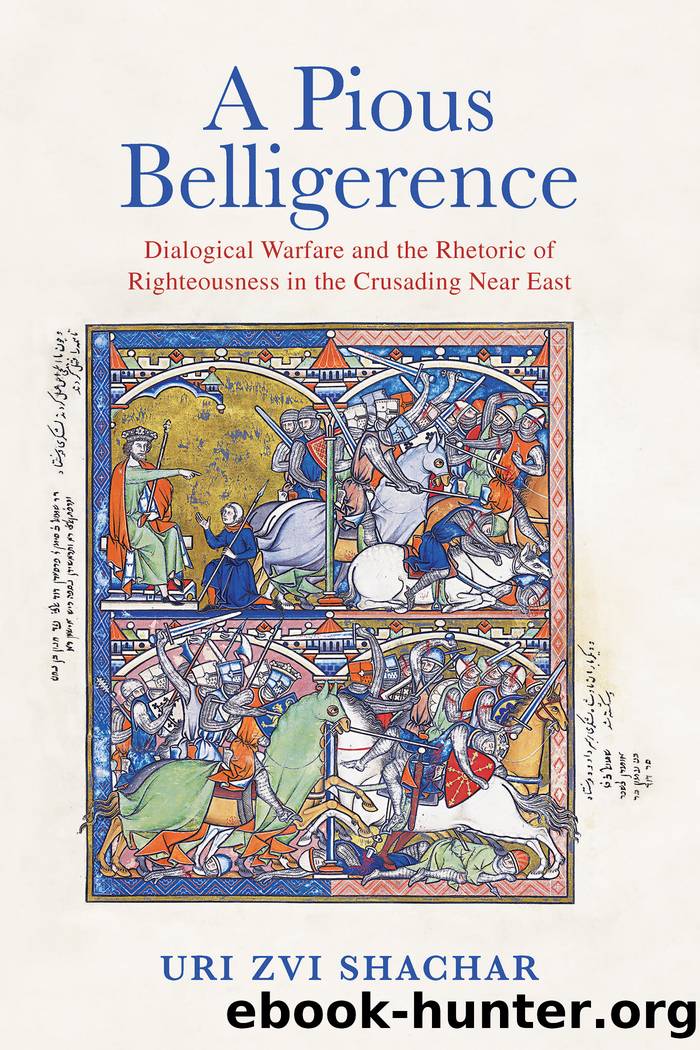A Pious Belligerence: Dialogical Warfare and the Rhetoric of Righteousness in the Crusading Near East by Uri Zvi Shachar

Author:Uri Zvi Shachar
Language: eng
Format: epub
Publisher: University of Pennsylvania Press
Published: 2021-03-15T00:00:00+00:00
Apocalypse in the Medieval WestâAdso of Montier-en-Der and Henri dâArci
The twelfth and thirteenth centuries saw a dramatic rise in the popularity and pervasiveness of apocalyptic literature in the West. One of the most common ways in which authors discussed âlast thingsâ was by deploying a historical exegesis of scripture. The Christological view of history is inherently eschatological in the belief that âhistory is a teleological process and that scripture reveals truths about its end.â78 In the later twelfth century, however, there emerged a genre of exegesis that primarily revolved on an attempt to align history with prophecy by identifying various scriptural apocalyptic schemes in key events of the Church.79 The best known and most influential twelfth-century exegete to advance this approach was the Calabrian Joachim of Fiore.80 Throughout the late Middle Ages, followers of the Joachite methodology deciphered passages from scripture to discover patterns that serve as a âlegendâ to interpret contemporary events through the lens of biblical prophecy.
In addition to these formal treatises on âlast thingsâ and biblical commentaries, there appeared in both Latin and the vernaculars an abundance of short prophecies that circulated throughout Latin Christendom.81 Typically pseudonymous, many of these compositions closely conformed to earlier traditions that had been handed down from patristic and early medieval periods. Much like the author of the Homily of the King Messiah, Christian writers invoked earlier traditions to produce texts with an ancient allure but introduced highly revealing changes that helped adjust the earlier text to the time and agenda of the author.
One such prophecy was composed in the seventh century and falsely attributed to Methodius, the fourth-century Bishop of Patara.82 This highly stirring text is situated in the context of the Muslim conquests. It describes the devastation that was brought on the Christians and predicts the arrival of the Antichrist and the Last Judgment.83 Pseudo-Methodius was probably composed originally in Syriac, but in the eighth century, it was translated into Latin and later to various vernaculars; it circulated widely in Europe and has a significant impact on a wide range of apocalyptic compositions.84 The imprint of the Methodius tradition is felt strongly, for example, in the Christian Ten Signs literature.
Multiple compositions circulated in Europe that sought to enumerate âsignsâ announcing the coming of the Antichrist and the Judgment Day. Unlike their Jewish counterparts, who composed collections of Ten Signs, Christian authors tended to enumerate fifteen.85 By far the most widely disseminated and influential early middle apocalypse, however, was the one composed by Adso, a reforming Benedictine monk and later abbot of Montier-en-Der.86 In the year 950, Adso composed a full account of the Antichrist, mostly on the basis of earlier sources. The text, in its original form, was addressed to Queen Gerberga and contained a dedicatory paragraph that is often omitted in later recensions. The work, whose greatest novelty lies in the authorâs choice to adhere to the structure of the popular saintsâ lives, gained immense reputation and circulated widely.87 Adsoâs letter on the Antichrist, in Latin or vernacular, circulated
Download
This site does not store any files on its server. We only index and link to content provided by other sites. Please contact the content providers to delete copyright contents if any and email us, we'll remove relevant links or contents immediately.
| Buddhism | Christianity |
| Ethnic & Tribal | General |
| Hinduism | Islam |
| Judaism | New Age, Mythology & Occult |
| Religion, Politics & State |
Cecilia; Or, Memoirs of an Heiress — Volume 1 by Fanny Burney(31341)
Cecilia; Or, Memoirs of an Heiress — Volume 3 by Fanny Burney(30938)
Cecilia; Or, Memoirs of an Heiress — Volume 2 by Fanny Burney(30894)
The Secret History by Donna Tartt(16642)
Sapiens: A Brief History of Humankind by Yuval Noah Harari(13067)
Leonardo da Vinci by Walter Isaacson(11912)
The Radium Girls by Kate Moore(10914)
Sapiens by Yuval Noah Harari(4545)
The Wind in My Hair by Masih Alinejad(4427)
How Democracies Die by Steven Levitsky & Daniel Ziblatt(4407)
Homo Deus: A Brief History of Tomorrow by Yuval Noah Harari(4286)
Endurance: Shackleton's Incredible Voyage by Alfred Lansing(3851)
The Silk Roads by Peter Frankopan(3767)
Man's Search for Meaning by Viktor Frankl(3644)
Millionaire: The Philanderer, Gambler, and Duelist Who Invented Modern Finance by Janet Gleeson(3573)
The Rape of Nanking by Iris Chang(3520)
Hitler in Los Angeles by Steven J. Ross(3442)
The Motorcycle Diaries by Ernesto Che Guevara(3340)
Joan of Arc by Mary Gordon(3262)
